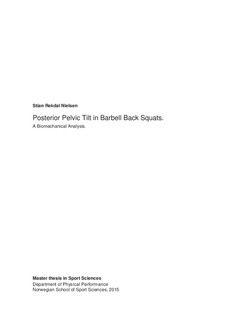| dc.description.abstract | The squat is one of the most used exercises in both performance and
rehabilitation exercise programs (37). Squatting with a full ROM is beneficial for
increasing strength and cross sectional area of the working muscles (3, 32). However, not
everyone is able to perform a full range of motion squat without curving his or her back.
Trunk flexion, or posterior pelvic tilt, in squat seem to increase shear forces on the lumbar
segment, and can potentially increase risk of spinal injury. This study aimed to compare
two groups subjectively evaluated to excessive- and no pelvic tilt. Secondly, quantify
degree of pelvic tilt, and investigate how different foot positions alter the kinematics of
barbell back squats.
Method: Seventy-eight subjects were recruited for a video recording and subjective
assessment of posterior pelvic tilt while performing squats. Subjects were then categorized
into three groups: excessive-, medium-, and low posterior pelvic tilt. Forty-three subjects
from the excessive- and low posterior pelvic tilt group completed a second session,
consisting of a 3D motion analysis performing squats in three different foot positions:
Narrow stance (NS), Plantar Flexed stance (PFS), and wide & externally rotated (WS). | nb_NO |
